Amphibious vehicle

An amphibious vehicle (or simply amphibian), is a vehicle or craft, that is a means of transport, viable on land as well as on water.
This definition applies equally to any land and water transport, small or large, powered or unpowered, ranging from amphibious bicycles, ATVs, cars, buses, trucks, and military vehicles, all the way to the very largest hovercraft. Classic landing craft are generally not considered amphibious vehicles, although they are part of amphibious assault.
General technical notes


Apart from the distinction in sizes mentioned above, two main categories of amphibious vehicle are immediately apparent: those that travel on an air-cushion (Hovercraft) and those that don't. Amongst the latter, many designs were prompted by the desire to expand the off-road capabilities of land-vehicles to an "all-terrain" ability, in some cases not only focused on creating a transport that will work on land and water, but also on intermediates like ice, snow, mud, marsh, swamp etc. This explains why many designs use tracks in addition to or instead of wheels, and in some cases even resort to articulated body configurations or other unconventional designs such as screw-propelled vehicles which use auger-like barrels which propel a vehicle through muddy terrain with a twisting motion.,[1][2]
Most land vehicles – even lightly armored ones – can be made amphibious simply by providing them with a waterproof hull and perhaps a propeller. This is possible as a vehicle's displacement is usually greater than its weight, and thus will float. Heavily armored vehicles however sometimes have a density greater than water (their weight in kilograms exceeds their volume in litres), and will need additional buoyancy measures. These can take the form of inflatable floatation devices, much like the sides of a rubber dinghy, or a waterproof fabric skirt raised from the top perimeter of the vehicle.
For propulsion in or on the water some vehicles simply make do by spinning their wheels or tracks[3][4], while others can power their way forward more effectively using (additional) screw propeller(s) or water jet(s). Most amphibians will work only as a displacement hull when in the water – only a small number of designs have the capability to raise out of the water when speed is gained, to achieve high velocity hydroplaning, skimming over the water surface like speedboats.
History
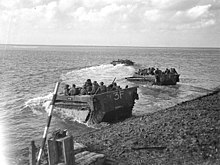
Some of the earliest known amphibious vehicles were amphibious carriages, the invention of which is credited to the notorious Neapolitan Prince Raimondo di Sangro of Sansevero (ca. 1750[dead link]) or Sir Samuel Bentham (1781).
The first known self-propelled amphibious vehicle, a steam-powered wheeled dredging barge, named the Orukter Amphibolos, was conceived and built by United States inventor Oliver Evans in 1805, although it is disputed to have successfully travelled over land or water under its own steam.[5]

Although it is unclear who (and where and when) built the first combustion-engined amphibian, in all likelihood the development of powered amphibious vehicles didn't start until 1899. Until the late 1920s the efforts to unify a boat and an automobile mostly came down to simply putting wheels and axles on a boat hull, or getting a rolling chassis to float by blending a boat-like hull with the car's frame (Pohl, 1998). One of the first reasonably well documented cases was the 1905 amphibious petrol-powered carriage of T. Richmond (Jessup, Iowa, USA). Just like the world's first petrol-powered automobile (1885, Carl Benz) it was a three-wheeler. The single front wheel provided direction, both on land and in the water. A three-cylinder petrol combustion-engine powered the oversized rear wheels. In order to get the wheels to provide propulsion in the water, fins or buckets would be attached to the rear wheel spokes. Remarkably the boat-like hull was one of the first integral bodies ever used on a car (Pohl, 1998).
Since the 1920s development of amphibious vehicles greatly diversified. Numerous designs have been created for a broad range of applications, including recreation, expeditions, search & rescue, and military, leading to a myriad of concepts and variants. In some of them the amphibious capabilities are central to their purpose, whereas in others they are only an expansion to what has remained primarily a watercraft or a land vehicle. The design that came together with all the features needed for a practical all terrain amphibious vehicle was by Peter Prell of New Jersey. His designed unlike others could operate not only on rivers and lakes but the sea and did not require firm ground to enter or exit the water. combined a boat like hull with tank like tracks. In 1931 he tested a scaled down version of his invention.[6]
Wheeled
Unarmored
ATVs

Amongst the smallest non air-cushioned amphibious vehicles are amphibious ATVs (all-terrain vehicles). These saw significant popularity in North America during the 1960s and early 70s. Typically an amphibious ATV (AATV) is a small, lightweight, off-highway vehicle, constructed from an integral hard plastic or fibreglass bodytub, fitted with six (sometimes eight) driven wheels, with low pressure, balloon tires. With no suspension (other than what the tires offer) and no steering wheels, directional control is accomplished through skid-steering – just as on a tracked vehicle – either by braking the wheels on the side where you want to turn, or by applying more throttle to the wheels on the opposite side. Most contemporary designs use garden tractor type engines, that will provide roughly 25 mph top speed on land.
Constructed this way, an AATV will float with ample freeboard and is capable of traversing swamps, ponds and streams as well as dry land. On land these units have high grip and great off-road ability, that can be further enhanced with an optional set of tracks that can be mounted directly onto the wheels. Although the spinning action of the tires is enough to propel the vehicle through the water – albeit slowly – outboard motors can be added for extended water use.
Cars


Amphibious automobiles have been conceived from ca. 1900, however the Second World War significantly stimulated their development. Two of the most significant amphibious cars to date were developed during World War II. The most proliferous was the German Schwimmwagen, a small jeep-like 4x4 vehicle designed by the Porsche engineering firm in 1942 and widely used in World War II. The amphibious bodywork was designed by Erwin Komenda, the firm's body construction designer, using the engine and drive train of the Kübelwagen. An amphibious version of the Willys MB jeep, the Ford GPA or 'Seep' (short for Sea jeep) was developed during World War II as well. A specially modified GPA, called Half-Safe, was driven and sailed around the world by Australian Ben Carlin in the 1950s.
One of the most capable post-war amphibious off-roaders was the German Amphi-Ranger, that featured a hull made of seawater-resistant AlMg2 aluminium alloy. Extensively engineered, this costly vehicle was proven seaworthy at a Gale force 10 storm off the North Sea coast (Pohl, 1998). Only about 100 were built – those who own one have found it capable of crossing the English Channel almost effortlessly.
Purely recreational amphibian cars include the 1960s Amphicar and the contemporary Gibbs Aquada. With almost 4.000 pieces built, the Amphicar is still the most successfully produced civilian amphibious car to date. The Gibbs Aquada stands out due to its capability of high speed planing on water. Gibbs built a couple dozen Aquadas in the early 2000s after it was developed by a team assembled by founder Alan Gibbs before the company's engine supplier, Rover, was unable to continue providing engines. Gibbs and new partner Neil Jenkins reconstituted the company and are now seeking U.S. regulatory approval for the Aquada. http://www.thedetroitbureau.com/2010/07/carboat-stalled-gibbs-to-launch-amphibious-atv/
Other amphibious cars currently in production include the Dutton Commander 'AmphiJeep' (GB) and the US Hydra Spyder. WaterCar has plans for a couple of "turnkey minus" cars, which would allow the vehicles to be sold in the U.S. <http://amphibiouswllz.com/?p=77#more-77> There are also several Chinese designs like the JMC BY5020TSL (see also) and BJ5032(XZHE)[dead link], and the even longer JMC JX5021TLYDS. American distributor Rodedawg [dead link] is now seeking to bring an adapted version of the Chinese amphibs to America.
Cycles
An amphibious cycle is capable of operation on both land and water. The design which has probably received the most coverage is Saidullah’s Bicycle.[7] This has been featured on both the Discovery Channel and BBC News. The bike uses four rectangular air filled floats for buoyancy, and is propelled using two fan blades which have been attached to the spokes. Moraga’s Cyclo Amphibious [8] uses a simple tricycle frame to support three floaters which provide both the floatation and thrust. The wings on the powered wheels propel the vehicle in a similar way to a paddle wheel.
Another design is the SBK Engineering Shuttle-Bike. It consists of 2 inflatable floats with straps that allow the carrying of a bicycle with passenger. The ensemble, when deflated, fits in a backpack for carrying by the cyclist. [9]
Yet another Amphibious Vehicle, featured in the Southern Daily Echo (5 June 2008) and The Daily Telegraph (6 June 2008) is that of seven engineering students at the University of Southampton.[10] The Amphibious Cycle combines a recumbent frame with separate floats, and is propelled using a paddle wheel. A speed test on water achieved an average speed of 1.12 m/s. The cyclist was able to transition the cycle both into and out of the water unassisted. This elegant prototype has a real application in urban areas of flooding, as well as applications in the leisure industry.
The most recent Amphibious Vehicle was created by five engineering students at Calvin College as a senior design project (May 2010). This vehicle improves upon previous designs by allowing smooth transition from water to land. [11]
Buses

Amphibious buses are employed in some locations as a tourist attraction. A recent design is the AmphiCoach GTS-1.
Trucks and barges


With more than 20,000 units produced, the DUKW was the most successful amphibious truck of World War II. This 31-foot (9.4 m) 6x6 truck was deployed in the Pacific theatre to establish and supply beachheads. It was designed as a wartime project by Sparkman & Stephens, the famous yacht design firm who also designed the hull for the Ford GPA 'Seep'. During the war, Germany produced the Landwasserschlepper and Schwimmwagen, and in the '50s, the Soviets developed the GAZ 46, BAV 485, and PTS.
During the Vietnam War, the US Army used the amphibious articulated Gama Goat and the larger Caterpillar 'Goer' truck-series to move supplies through the canals and rice paddies of Southeast Asia. The latter was based on a 1950s civil construction vehicle and became the US Army’s standard heavy tactical truck before its replacement by the HEMTT. Although the vehicles' wheels were mounted without suspension or steering action, and land speeds over 20 mph were ill-advised, its articulated design provided it with good maneuverability and helped it to keep all four wheels firmly in touch with uneven ground. Coupled with its amphibious capability, in the Vietnam War (especially during raining season), the M520 Goer developed a reputation of being able to go where other trucks could not.
For taking vehicles and supplies onto the beaches the US used the 1950s designed LARC-V and the huge LARC-LX or "BARC". At 63 feet (19 m) long and 27 feet (8.2 m) wide the latter is one of the largest wheeled amphibians to date. It could carry up to 100 tons of cargo or 200 people, but a more typical load was 60 tons of cargo or 120 people. The vehicle was powered by four V8 diesel engines positioned in the sides of the hull, each driving a single 8-foot (2.4 m) wheel.
The United Kingdom used the 6x6 wheeled Alvis Stalwart as their amphibious cargo carrier. This highly mobile 5-ton truck entered service with the British Army in 1966. In the water it was driven by vectored thrust water-jet propulsion units at about 6 knots.
American manufacturer Terrawind currently offers civilian amphibious buses and motorcoaches.
EWK Eisenwerke Kaiserslautern GmbH developed the M3 Amphibious Rig that can be used as a ferry and as a floating bridge for trucks and heavy combat vehicles.
Armored

Many modern military vehicles, ranging from light wheeled command and reconnaissance, through armoured personnel carriers and tanks, are manufactured with amphibious capabilities. Contemporary examples of wheeled armored amphibians are the French Panhard VBL and GIAT Industries VAB.
The VBL (Véhicule Blindé Léger or "Light armoured vehicle") is a compact, lightly armored 4x4 all-terrain vehicle that is fully amphibious and can swim at 5.4 km/h. The VAB (Véhicule de l'Avant Blindé or "Armored Vanguard Vehicle") is a fully amphibious Armoured personnel carrier (APC), powered in the water by two water jets, mounted one on either side of the rear hull (see detail picture above). It entered service in 1976 and around 5000 were produced in numerous configurations, ranging from basic personnel carrier, anti-tank missile platform to riot control versions with a water cannon.
During the Cold War the Soviet bloc states developed a number of amphibious APCs, fighting vehicles and tanks, both wheeled and tracked. Most of the vehicles the Soviets designed were amphibious, or could ford deep water. Wheeled examples are the BRDM-1 and BRDM-2 4x4 armored scout cars, as well as the BTR-60, BTR-70, BTR-80 and BTR-94 8x8 armored personnel carriers and the BTR-90 infantry fighting vehicle.
Tracked
Unarmored
The M29 Weasel (Studebaker Weasel), whilst originally designed as a snow vehicle, operated successfully in amphibious role by the addition of front and rear floats. The basic vehicle will float but its bow is square so the additional floats add stability and load carrying capacity.
Armored

Among tracked armored vehicles with amphibious capabilities are first of all those that are intended for use in amphibious assault. The United States started developing a long line of LVT (Landing Vehicle Tracked) designs from ca. 1940. The US Marine Corps currently uses the AAV7-A1 Assault Amphibious Vehicle, which is to be succeeded by the Expeditionary Fighting Vehicle (previously AAAV), which is capable of planing on water and can achieve water speeds of 37–46 km/h.
A significant amount of tracked armored vehicles that are primarily intended for land-use, such as Armoured fighting vehicles and Infantry fighting vehicles nevertheless also have amphibious ability, tactically useful inland, reducing dependence on destroyable and easily-targeted bridges. To provide motive power, they use their tracks, sometimes with added propeller or water jets. As long as the opposite bank has a shallow enough slope for the APC, AFV or IFV to climb out within a few miles, they can cross rivers and water obstacles. American examples are the M113 Armored Personnel Carrier and the M2 Bradley. Soviet examples are the PT-76 amphibious tank, and the BTR-50 and MT-LB APCs based on its chassis.
Some heavy tanks have an amphibious mode in which a fabric skirt is needed to add buoyancy. The Sherman DD tank used in the D-Day invasion had this setup. When in water the waterproof float screen was raised and propellers deployed. The M2 and M3 Bradleys also need such a skirt.
Tanks
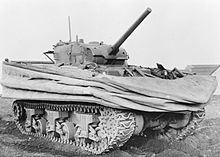
At the end of World War I a Mark IX tank had airdrums attached to the side and was tested as an Amphibious vehicle.[12]
In World War II the British further developed amphibious tanks. The Crusader was trialled with two pontoons that could be attached or removed, the tracks driving the tank in the water. The "Medium Tank A/T 1" was a tank with inbuilt buoyancy some 24 ft long and 11 ft tall. The Valentine, then the M4 Medium tank were made amphibious with the addition of a rubberized canvas screen to provide additional buoyancy and propellers driven by the main engine to give propulsion. These were DD tanks (from "Duplex Drive") and the Sherman DD was used on D-Day to provide close fire support on the beaches during the initial landings. The Sherman DD could not fire when afloat as the buoyancy screen was higher than the gun. A number swamped and sank in the operation, due to rough weather in the English Channel (with some tanks having been launched too far out), and to turning in the current to converge on a specific point on the battlefield, which allowed waves to breach over the screens. Those making it ashore, however, provided essential fire support in the first critical hours.
Before World War II, The Soviets produced light amphibious tanks called T-37 and T-38. A third serial model, T-40, started production after the beginning of the war. A 14 ton tank, PT-1 was created, but was not mass produced. In addition, an attempt was made to attach pontoons to T-26. While successful, the project was closed due to the high vulnerability and unwieldiness of the construction.

Some light tanks such as the PT-76 are amphibious, typically being propelled in the water by hydrojets or by their tracks. In 1969, the U.S. Army rushed the new M551 Sheridan to Vietnam. This 17 ton light tank was built with an aluminium hull, steel turret and gun (although the 152 mm gun was called a "launcher" at the time), and could swim across bodies of water. The M551 upon arrival in Vietnam began replacing the M48A3 Patton in all cavalry squadrons, leaving only the M48A3 in the U.S. Army's three armored battalions in Vietnam, the 1/77th, 1/69th, and the 2/34th Armor. The Sheridan needed no modifications for river crossings, crewmen simply raised the cloth sides that were tucked inside rubber tubes along the hull's upper edges, raised the driver's front shield which had a acrylic glass window, the driver turned on his bilge pumps, shifted his transmission lever to water operations and the Sheridan entered the water. For newly arrived Sheridans, this might work as engineered. For "war weary" M551s, the driver's window was often "yellowed" and/or cracked as to obscure his vision, and the rubber tubes that contained the rolled up side sleeves were often cracked and/or frozen into place. The Sheridan could still cross a body of water, but like its swimming cousin, the M113 APC (Armoured Personnel Carrier, also built of aluminium) the river had to be narrow, less than 100 yards (100 m). In all cases, the bilge pumps had to be working properly, and even then by the time the Sheridan or the APC reached the other side, water would often fill the insides up to their armoured roofs, spilling through the hatches' cracks and emptying onto the earth once safely ashore. Often a fold down trim vane is erected to stop water washing over the bow of the tank and thus reducing the risk of the vehicle being swamped via the driver's hatch.
Multi-unit
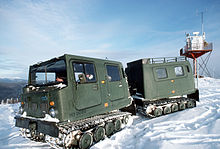
The unique capability that distinguishes multi-unit vehicles from single unit ones, is the ability to help each other. According to a 1999 article in Military Parade magazine, multi-unit, all-terrain transport vehicles were first proposed by the British in 1913, and by the 1950s, over 40 types of articulated tracked vehicles (ATVs) were in production. The articulated tracked concept is chosen primarily for its combination of high maneuverability, cross-country abilities, and remarkable load-carrying capacity. In some cases the design is made amphibious, giving them all-terrain capability in the truest sense. Usually the front unit houses at least the engine, gearboxes, fuel tank(s) and the driver's compartment, and perhaps there is some space left for cargo or passengers, whereas the rear unit is the primary load carrier.
Examples of this concept are the Russian Vityaz DT-(10/20/30)P[dead link] models, the Swedish Volvo Bv202 and Hagglunds Bv206 designs, and Singapore Bronco ATTC (All-Terrain Tracked Carrier).
A highly specialised development is the Arktos expedition and evacuation craft, that uses a linkage with two joints to connect the two units, as well as fitting each unit with its own engine, to give each unit enhanced independence of movement.
Deep fording
Some military vehicles are not truly amphibious but are capable of "wading" using waterproof screens to keep the upper hull dry. In World War II the tanks following the Sherman DDs were given waterproofed hulls and trunking was fixed to the engine intakes and exhausts to allow them to come ashore from landing craft in shallow water. The Germans gave their Tiger tank a long snorkel, essentially a long tube on the commander's hatch that allowed it to wade through four metres of water.
The Leopard 2 tank carries a snorkel that is in fact a series of rings which can be stacked to create a long tube. This tube is then fitted to the crew commander's hatch and provides air and an escape route for the crew. The height of the tube is limited to around three meters.
All modern Soviet/Russian tanks like the T-90 are also able to perform deep fording operations, however unlike the Leopard, the Russian snorkel is only a few inches round and does not provide a crew escape path, although it is more practical and can be stored on the tank.
Hovercraft
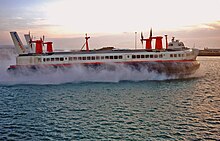
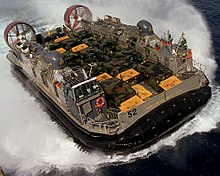
For certain applications wheeled and tracked amphibious vehicles are slowly being supplanted by air-cushioned landing craft in many modern militaries. An air-cushion vehicle (ACV) or hovercraft is designed for traveling over land or water supported by a cushion of slow moving, low-pressure air ejected downwards against the surface below it. In principle a hovercraft can travel over any sufficiently smooth surface, solid, liquid, mixed, or anything in between. Considering that hovercraft can be quite large, some riding on an air-cushion contained by skirts several meters tall, these can deal with a reasonable level of unevenness in the terrain, unfazed by obstacles 1 to 2 meters in height. On the other hand the smallest personal hovercraft—ACVs no bigger than a compact hatchback—are nimble enough to follow some rolling of the terrain just as easily.
One of the benefits of this type of amphibious craft is the possibility of making them large—the British-built SR-N4 Mk-3 Channel-crossing ferries were 56.4 m (185 ft) in length and 23.8 m (78 ft) wide. Other benefits of ACVs include their very high water speed (an SR-N4 Mk-1 could do 83 knots (95 mph or 154 km/h) and the fact that they can make the transition from land to water (or vice versa) at speed—contrary to most wheeled or tracked amphibians. Drawbacks are high fuel consumption and noise levels.
For military purposes, the hovercraft's ability to distribute its laden weight evenly across the surface below it makes it perfectly suited to the role of amphibious landing craft. The US Navy LCAC can take troops and materials (if necessary an M1 Abrams tank) from ship to shore and can access more than 70% of the world's coastline, as opposed to conventional landing craft, that have only about 17% of that coastline available to them for landing.
Photo Gallery
-
Japanese Beach Minelayer Vehicle as Type94
References
- ^ development of this concept is so-called "TESH-drive or transformable worm" from russian inventor Alexey Burdin.verb=getRecord&metadataPrefix=html&identifier=AD0456539 Marsh Screw Amphibian
- ^ Getty Images - Unsupported browser detected
- ^ Fast Track Amphibian FastTrack 1
- ^ Howe and Howe Tech Personal Assault Lander
- ^ AmericanHeritage.com / Was This America’s First Steamboat, Locomotive, and Car?
- ^ "Strange At Home On Land And Water", April 1931, Popular Science
- ^ Shourie, D. (2006) Grassroots inventions The Tribune, Chandigarh, India. 17th February 2006.
- ^ Moraga, E.O. (1969) 21 September 1971 Cyclo Amphibious US Patent 3,606,856.
- ^ SBK Engineering Shuttle-bike
- ^ Anthony Chesshire, David Edwards, Simon Halford, Joanna Hutchinson, Jack Marriott, Andrew Webster & Simon Wiles (2008) Design Build and Test an Amphibious Cycle School of Engineering Sciences, University of Southampton.
- ^ https://knightvision.calvin.edu/bbcswebdav/orgs/ENGR/senior-projects/2009_10/team15/web/index.html
- ^ Foss, Christopher F (1988). The Vickers tanks From landships to Challenger. Patrick Stephens Limited. p. 28. ISBN [[Special:BookSources/1-85360-141-8|1-85360-141-8[[Category:Articles with invalid ISBNs]]]].
{{cite book}}: Check|isbn=value: invalid character (help); Unknown parameter|coauthors=ignored (|author=suggested) (help)
Further reading
- René Pohl: Mit dem Auto baden gehen. HEEL Verlag, Gut-Pottscheidt Konigswinter 1998, ISBN 3-89365-702-9
- Ben Carlin, Half-Safe, Andre Deutsch Ltd 1955
- Ben Carlin, The Other Half of Half-Safe, ISBN 0-9598731-1-2, Guildford Grammar School Foundation 1989
External links
- UK based site all about the 1960s German Amphicar
- The A to Z 'Amphiclopy'
- "Amphibious" Land Rover
- Terra Wind,Cool Amphibious Manufacturers International
- ATON IMPULSE, Amphibious Emergency and Rescue Vehicle Manufacturer
- The Museum of Creative Invention of multirole vehicles; see also their extensive
- external links page.
- A site for Amphibious ATV vehicles



